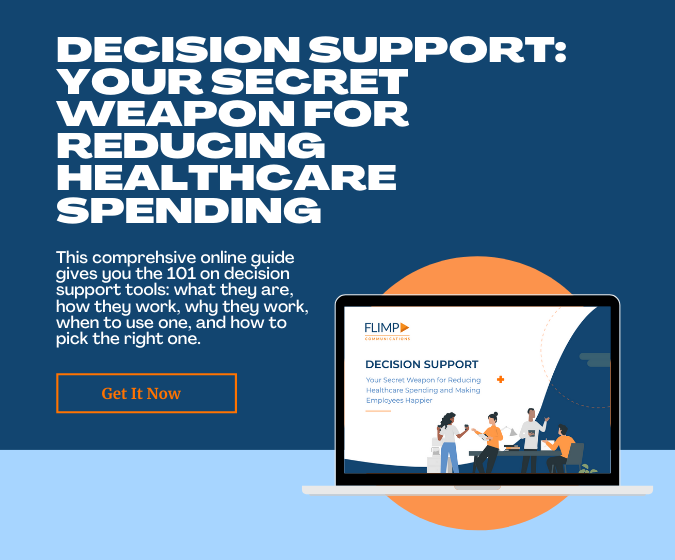 The weather is starting to cool. The leaves are beginning to change colors. Pumpkin spice everything has hit the store shelves. That means just one thing. Open enrollment season for healthcare is here, and the time for benefits decision-support tools to shine is now.
The weather is starting to cool. The leaves are beginning to change colors. Pumpkin spice everything has hit the store shelves. That means just one thing. Open enrollment season for healthcare is here, and the time for benefits decision-support tools to shine is now.
Open enrollment’s roots are in the intricacies of the insurance business. Basically, you don’t want people taking out a policy when they need it and then dropping it once the crisis has passed. At the same time, you don’t want policyholders shackled for all eternity to an insurer they don’t like.
So, open enrollment season is the one time of the year where the insured can take their business elsewhere, or purchase a different policy from their current insurer. And insurers use this period to attract new business and refine their offerings to suit the current business environment.
Insurers Are Prepared
The insurers are pretty well set for open enrollment. They have a whole department that has been focusing on it full time since the last open enrollment period ended. Even after open enrollment ends for the year, insurance company benefits administrators keep working to find cost drivers and trends while developing cost-containment strategies in response to real-time data.
Employees Are Not
Needless to say, employees don’t spend the same amount of time analyzing healthcare costs and trends. They’re busy doing their jobs. HR departments and benefits managers have always offered as much support as they can. The benefits decision-support tool offerings many now rely on are largely driven by technology.
(Learn more about the advantages and disadvantages of benefits decision support tools)
I’m old enough that I remember when companies discussed healthcare in your welcome packet. You received a manual that resembled a Russian novel – lots of pages, hundreds of unmemorable names and the more you read, the less you understand what’s going on. It was your job to parse out what it all meant and to decide what health coverage you needed.
Back then, I was younger and had less need for health coverage beyond the basics. It made my decisions pretty easy. But if you had a family, one of them with a chronic disease, finding the right plan was an adventure. One employer tried to make things a little easier with a decision tree, which computer programmers of old know as a flowchart. Using ‘yes’ and ‘no’ answers, you could find your way to the ‘best’ choice for your situation. It covered six pages. ‘Easier’ is a relative term.
Digital Advantage
Like almost everything else, computerization and digitization have made decisions about healthcare more accessible. Today, you can get to the helpful answers you seek quickly with decision-support tools.
One style of these tools is the calculator model. These are an improvement over the paper-and-pencil approach. You enter a load of information like the annual number of doctor visits for each family member, prescription requirements and some conjecture (like you might be trying to have a baby this year, so needs will radically change). It can take 25 to 40 minutes to enter it all.
These tools tend to give you the “optimal” result among the choices which your employer offers. If there are multiple options, you’ll usually be told which one is best rather than getting side-by-side comparisons.

Percentile of Use
A more robust style of benefits decision-support tool is the percentile-of-use model. At Flimp Communications, for instance, we offer PLANselect®, which helps employees choose the optimal health plan that will give them the lowest cost and best value based on their medical needs. Our predicted OOP cost data is far more accurate than calculator products.
With our approach, employees answer a few questions about their anticipated medical needs. Then the proprietary algorithms provide a personalized cost analysis and health plan comparison. This includes comparing premium costs, employee out-of-pocket costs (co-pays, deductibles) and employer HSA or HRA contributions.
Decision Making
These are, of course, only tools. They don’t decide for you. In theory, the better the tools, the better the decisions. But one of the things that needs to be driven home to employees is that they are in control of the process. The algorithms may suggest Plan A as the better plan for you, but maybe you’ve had a bad experience with that provider. Plan B is a little more expensive, but there isn’t the baggage of a negative history with the provider. You choose Plan B, and that’s perfectly fine.
That ability to choose needs to be communicated to employees. Benefits decision-support tools have to be introduced effectively to the workforce. These things can be off-putting. The jargon of healthcare is bad enough. No one likes the sound of a “high-deductible health plan.” Throw in terms like “percentile of use” and “algorithms” and eyes start to glaze over. As an HR leader or company manager, you need to make it not scary.
To that end, you should roll out a decision-support tool with its own communications initiative. Plan, get C-suite buy-in and find and engage appropriate ambassadors to help sell the idea to the others. The use of video is vital because it allows you to walk staff through the process. Once they’ve seen it used, the trepidation and resistance to using it fades.
Decision-support tools are a wonderful use of technology. But like all technology, they only improve life if and when they get used.







